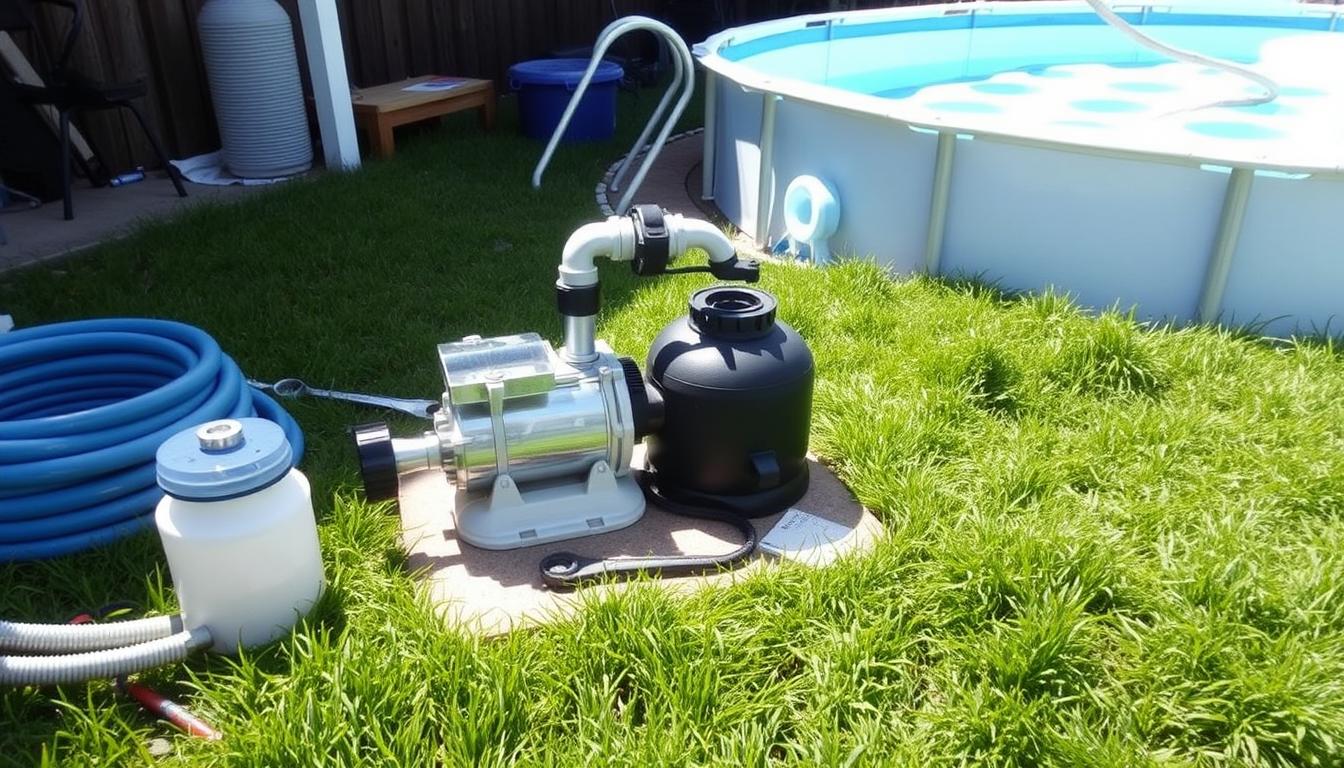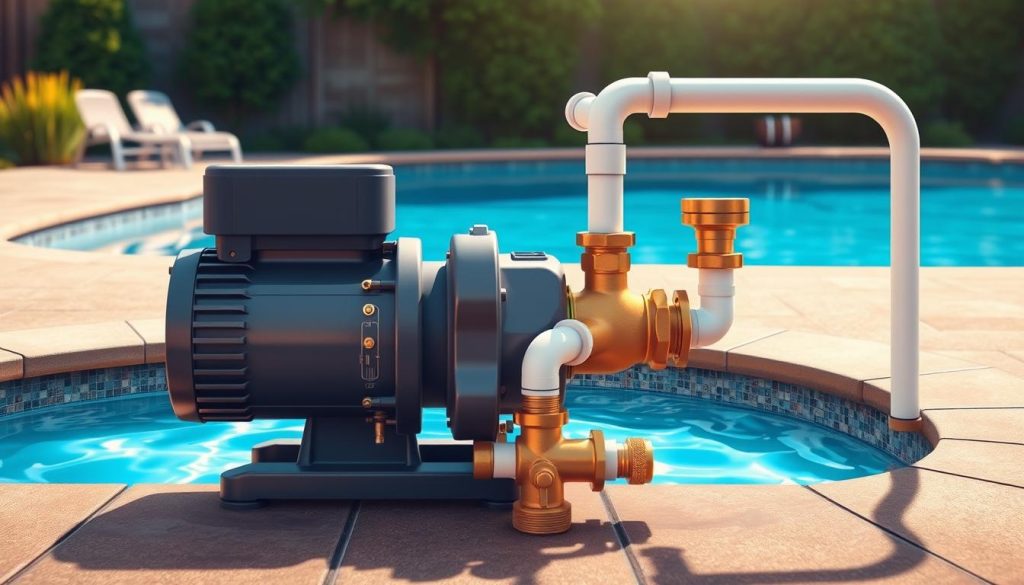
Using the right size pool pump can lead to significant energy savings. Choosing a pump with the correct horsepower and flow rate is crucial for efficient operation. Our guide will help you set up your pool pump easily.
When installing a pool pump, select one that matches your pool’s size. The new pump should have the same dimensions as the old one. This will make the installation process simpler.
If you choose a differently sized pump, you may need to adjust the plumbing lines. An energy-efficient pool pump, set up correctly, ensures good maintenance and lower energy costs.
Gathering the Necessary Tools and Supplies
Let’s get ready to install our pool pump. We’ll need the right tools and supplies for a smooth process. This will help us avoid delays and extra trips to the store.
Selecting the Right Pool Pump
Choose a pool pump that fits your needs. Think about your pool’s size, type, and filtration needs. BLACK + DECKER offers variable speed pumps for different pools.
Their pumps range from 1 HP to 3 HP. These energy-efficient options give better control over water flow. They can also help you save on energy costs.

Essential Plumbing Supplies
Gather PVC pipes, unions, couplings, elbows, tees, and pipe fittings. Schedule 40 PVC is the most common and durable option for pool plumbing.
Get a pipe cutter for clean cuts and PVC glue for strong bonds. Don’t forget silicone lubricant for O-rings and gaskets. It ensures proper seals and easier maintenance.
| Plumbing Supplies | Purpose |
|---|---|
| PVC Pipes | Connecting pump to pool plumbing |
| Unions, Couplings, Elbows, Tees | Joining pipes and changing directions |
| Pipe Fittings | Connecting pipes of different sizes |
| Pipe Cutter | Making precise cuts on PVC pipes |
| PVC Glue | Creating strong, watertight bonds |
| Silicone Lubricant | Lubricating O-rings and gaskets for proper sealing |
Electrical Tools and Safety Precautions
Safety is key when wiring a pool pump. You’ll need wire strippers, pliers, and electrical tape for DIY connections. Not sure about the wiring? Ask a pro.
An electrician can ensure proper wiring that follows local codes. This reduces risks of electrical hazards and future pump problems.
Having the right tools and supplies is crucial. With everything ready, you’ll save time and avoid frustration during installation.
Preparing for Installation
Setting up your pool pump correctly is vital. We’ll help you choose the best spot, remove the old pump, and prepare pipes. This ensures a smooth installation process.
Choosing the Ideal Pump Location
When picking a spot for your new pool pump, keep these factors in mind:
- Dry and Level: The area should be dry and level to prevent water accumulation around the pump and for stability.
- Accessibility: Choose a spot with easy access for maintenance and repair tasks. You don’t want to struggle to reach your pump when troubleshooting.
- Well-ventilated: The guide suggests placing the pump in a well-ventilated utilities room near the swimming pool to avoid external weather influences.
These factors help ensure easy installation and reduce future pool pump issues. A well-chosen location makes maintenance simpler and extends pump life.
Disconnecting the Old Pump
To safely remove your old pool pump, follow these steps:
- Power Off: Turn off the power to the pool pump and filtration system at the circuit breaker.
- Shut Off Valves: Close the valves on both sides of the pump to prevent water from flowing when you disconnect it.
- Disconnect Plumbing: Use wrenches to disconnect the plumbing from the old pump. Have a bucket and towels ready to catch any water that may spill out.
Always prioritize safety when working with electrical components and water. Double-check power is off before starting any work.
Measuring and Cutting Pipes
Accurate pipe measurements ensure your new pool pump fits perfectly. Here’s how to measure and cut pipes:
- Measure and Cut: Measure the distance between the pump’s inlet and outlet ports. Use a pipe cutter to make precise cuts.
- Smooth Edges: Use sandpaper to smooth the cut edges of the pipes, ensuring they fit snugly into fittings.
- Dry Fit: Assemble the pipes, fittings, and valves without glue to ensure everything fits as intended.
Keep pipe bends at 45 degrees or less to reduce resistance. The suction pipe should match or exceed the pump inlet size.
This prevents air trapping, which can damage the pump during priming. Proper pipe sizing ensures efficient pump operation.
How to Hook Up a Pool Pump
You’ve gathered tools, prepped the site, and removed the old pump. Now it’s time to connect your new pool pump. Follow these steps for a smooth installation.
Connecting the Threaded Adapters
Attach threaded adapters to the pump’s inlet and outlet ports. Wrap Teflon tape around threads to prevent leaks. Secure adapters tightly to avoid water loss during operation.
Installing the New Pump
Place your new pump on a solid, level surface near the chosen spot. Position it below the pool’s water level. This prevents air from entering the system.
A variable speed pump, like BLACK + DECKER’s Energy Star In-Ground VS Pool Pumps, can save energy. These pumps can cut electrical costs by up to 80% compared to standard ones.
Connecting the Plumbing
Use union fittings where possible for easier future maintenance. Apply PVC glue to pipe ends and fitting sockets. Insert pipes into fittings with a slight twist for secure connections.
We suggest using schedule 40 PVC pipes for durability. Hand-tighten unions to secure the pump to plumbing. Use wrenches carefully, avoiding over-tightening to prevent damage.
Wiring the Pump
Turn off power before connecting wires to avoid accidents. If you’re not experienced with electrical work, consult a professional.
Follow the pump’s manual for correct wiring. Connect wires using color codes. Use wire nuts or terminal blocks for secure connections.
Tip: Use sweep elbows and 2 or 2.5″ pipes to reduce restrictions. Replace side-mount Multiport valves with Slide Valves for sand and DE filters to boost efficiency.
| Pool Size | Recommended Pump | Speed Range (RPM) |
|---|---|---|
| Up to 30,000 gallons | Super Pump VS | 600-3000 |
| Over 40,000 gallons | TriStar VS | 600-3450 |
| Over 50,000 gallons or large waterfalls | Pentair Intelliflo VS | 600-3450 |
These steps will help you hook up your new pool pump successfully. Enjoy your properly functioning swimming pool filtration system. Regularly maintain your pump for longevity and efficiency.
Conclusion
Great job on finishing your pool pump installation! You’ve taken a big step towards better water circulation and filtration. The process is similar for both above ground and inground pool pumps.
Safety is crucial when dealing with electrical parts. Always turn off the power before starting. This can cut electrical hazards by 90%. Priming the pump can boost efficiency by 15%.
Following detailed guides like this one can reduce maintenance issues by 25%. Proper installation leads to fewer problems during swim season.
Keep an eye on your new pool pump’s performance. Check wiring, conduit, and connections often. Clean the filter to prevent blockages.
If you have questions, check the manual or ask a pro. With good care, your pool pump will keep your pool clean for years. Enjoy your swim!







